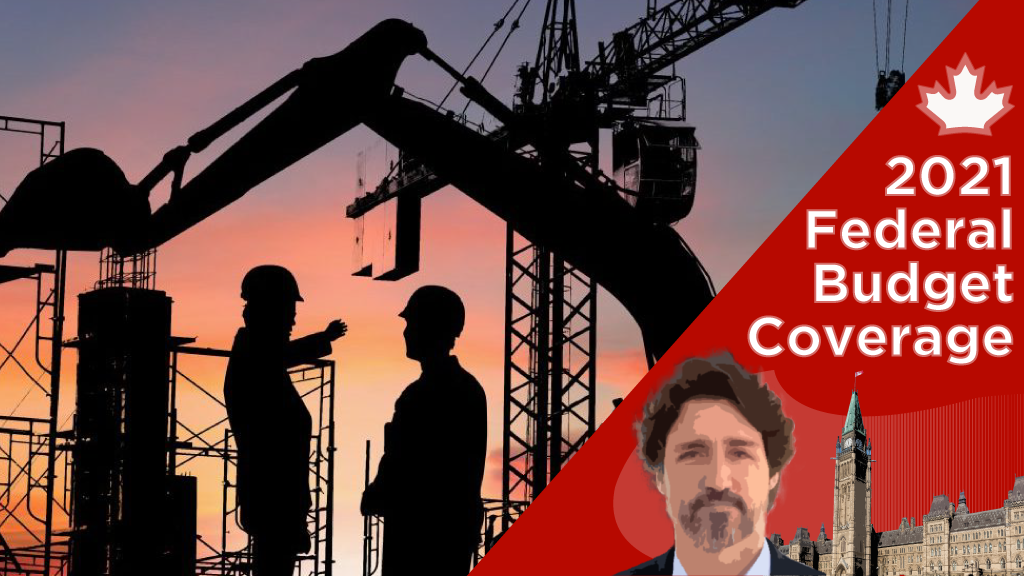Construction stakeholders and allies are praising the broad strokes of the federal budget presented April 19 with its commitment to infrastructure, green-economy initiatives and apprenticeship supports but a number expressed disappointment with omissions.
Federal Finance Minister Chrystia Freeland’s first budget delivered on a pledge issued last fall to spend up to $100 billion over three years to spur economic recovery coming out of the COVID-19 pandemic but observers noted some of the new spending was for “social infrastructure” rather than traditional stimulus infrastructure funding, and said the government failed to explain how delivery of projects would be expedited.
“It’s a very ambitious budget,” said John Gamble, president and CEO of the Association of Consulting Engineering Companies – Canada (ACEC). “And if everything goes right, there’s a lot of exciting potential for not just the infrastructure sector but for Canadians who will benefit from all manner of infrastructure.
“But a lot of things have to go right. This government’s taking a big chance that they’re going to see significant growth in the GDP.”
Stakeholders lauded government proposals for a new Apprenticeship Service, a $500-million Canada Community Revitalization Fund, a $1.9-billion National Trade Corridors Fund recapitalization, a $779-million Deep Home Retrofits program and an overall allocation of $17.6 billion to green recovery funding.
Other proposals that met with approval included a promised National Action Plan on Flooding, a boost to the gas tax fund, support for a $22.6-million National Infrastructure Assessment program and the Net Zero Accelerator program as well as a commitment to launch consultations aimed to mitigate the adverse impacts of unfairly traded steel.
The Progressive Contractors Association of Canada (PCA) called the budget a “huge, sprawling high-deficit social spending initiative,” referring to Freeland’s forecast of a spending shortfall of $154.7 billion for the 2021-22 fiscal year.
“Deficits unthinkable just a year ago have become the standard,” said Darrel Reid, the PCA’s vice-president of public affairs. “PCA members also have children, certainly in the skilled trades, who will be required to repay Canada’s debt that will charge way past one trillion dollars in the not-too-distant future.”
The government expects the deficit to decline to $30.7 billion by 2025-26.
Mechanical Contractors Association of Canada (MCAC) COO Ken Lancastle noted the government recognized in the budget that construction will be a key player in an economic recovery not only coming out of the pandemic but afterwards. The budget did not outline a path for broad new infrastructure investment, he said, but he commented there have been a number of previously announced infrastructure initiatives that will keep MCAC members working.
The MCAC is looking forward to further conversations with the government to ensure that projects are delivered promptly and efficiently, Lancastle added.
The Canadian Construction Association also stressed the need for a federal commitment “to facilitate the quick and unfettered roll-out” of its proposed investments.
“The budget endorses the valued role of the heavy civil, institutional, commercial and industrial construction sector to building back better,” said CCA president Mary Van Buren.
The CCA noted that government had delivered on several CCA pre-budget requests, including support for green and trade-enabling infrastructure investment, workforce capacity building, a commitment to a 25-year infrastructure plan and investment to advance innovation in construction.
Also addressing the infrastructure pipeline, Gamble praised the government for supporting infrastructure that would be delivered using social and green-transformation lenses to assess projects, but added the ACEC also wants “assurances that it’s not at the expense of some of the more routine, common-core infrastructure” that has been identified as critically lacking in the analysis of the Canadian Infrastructure Report Card.
Sean Strickland, executive director of Canada’s Building Trades Unions, said the council would have liked to see additional investments in infrastructure to address the gaps caused by reduced private sector investment.
But, Strickland added, “The creation of the new Apprenticeship Service…will encourage more employers to hire and start apprentices, including additional incentives for hiring those from underrepresented groups.”
The Canada Green Building Council issued a statement noting the budget prioritizes workforce training programs for high-growth sectors.
“Green building should benefit from this, as government programs like the Canada Infrastructure Bank’s Commercial Building Retrofits Initiative and Infrastructure Canada’s Green and Inclusive Communities increase demand for green-building and low-carbon skills,” the statement said.
A statement from the Canadian Apprenticeship Forum also focused on skills.
“We applaud the government for its continued support of the apprenticeship and skilled trades communities with financial supports,” stated the release. “Developing a National Apprenticeship Service is a strong start but (it’s) missing stakeholder consultation and buy-in to ensure meaningful priorities are included; developing a tracking system to allow for accountability and improvements; and creation of a national advisory committee to support the roll-out the plan.”
The Canadian Steel Producers Association (CSPA) highlighted the additional funding for the Net Zero Accelerator and new tax measures to support technologies such as carbon capture and storage as positive measures in the budget
Catherine Cobden, president and CEO of the CSPA, also praised the government’s allocation of additional funding to support monitoring of steel imports.
“What this will give is transparency to the marketplace,” said Cobden. “A benefit to the construction industry is a strong, robust domestic steel supply chain to remain competitive and strong.”
Follow the author on Twitter @DonWall_DCN.











Recent Comments